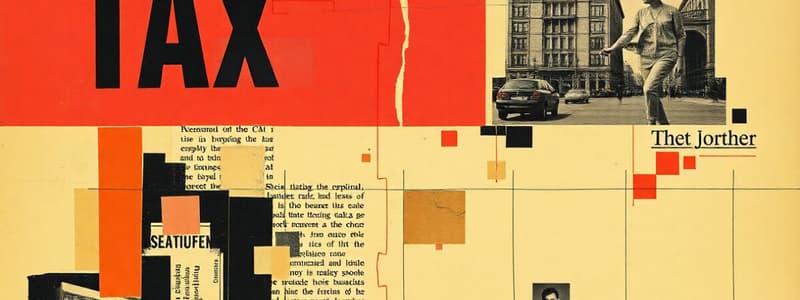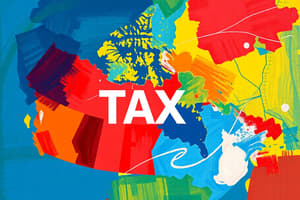Podcast
Questions and Answers
What percentage of revenue is generated from sales taxes?
What percentage of revenue is generated from sales taxes?
- 17%
- 22%
- 13%
- 18% (correct)
Which type of tax is primarily used to fund local services like schools and fire protection?
Which type of tax is primarily used to fund local services like schools and fire protection?
- Sales taxes
- Property taxes (correct)
- Federal taxes
- Income taxes
What is the primary purpose of taxation according to the content?
What is the primary purpose of taxation according to the content?
- To raise revenues for public goods (correct)
- To promote economic growth
- To provide subsidies for agriculture
- To support businesses directly
How does a progressive tax system function?
How does a progressive tax system function?
What percentage of revenue is attributed to individual income taxes?
What percentage of revenue is attributed to individual income taxes?
What is the marginal tax rate?
What is the marginal tax rate?
Transfer payments are intended to address which of the following issues?
Transfer payments are intended to address which of the following issues?
Which of the following accurately describes a proportional tax system?
Which of the following accurately describes a proportional tax system?
What does marginal analysis primarily focus on when evaluating alternatives?
What does marginal analysis primarily focus on when evaluating alternatives?
Which concept represents the extra cost incurred by shifting from one feasible alternative to another?
Which concept represents the extra cost incurred by shifting from one feasible alternative to another?
When the total cost curve has a bowl-like shape, what will marginal analysis predict?
When the total cost curve has a bowl-like shape, what will marginal analysis predict?
What is the Principle of Optimization at the Margin based on?
What is the Principle of Optimization at the Margin based on?
What should be excluded when performing marginal analysis?
What should be excluded when performing marginal analysis?
What indicates a decision to move farther away from the city center is optimal?
What indicates a decision to move farther away from the city center is optimal?
What does the Marginal Commuting Cost reflect?
What does the Marginal Commuting Cost reflect?
What is the main advantage of using marginal analysis over total value optimization?
What is the main advantage of using marginal analysis over total value optimization?
What is a major flaw of command economies as described?
What is a major flaw of command economies as described?
How does a market economy determine the allocation of resources?
How does a market economy determine the allocation of resources?
What characterizes a constrained optimization problem?
What characterizes a constrained optimization problem?
What condition must hold for a buyer to be in consumer equilibrium?
What condition must hold for a buyer to be in consumer equilibrium?
What is meant by Pareto efficiency in a perfectly competitive market?
What is meant by Pareto efficiency in a perfectly competitive market?
What should a buyer do if the marginal benefit from one good is greater than that from another?
What should a buyer do if the marginal benefit from one good is greater than that from another?
What does the concept of equity in economics primarily focus on?
What does the concept of equity in economics primarily focus on?
How does a price change of one good affect the budget constraint?
How does a price change of one good affect the budget constraint?
Why do planned economies typically face difficulties in responding to consumer demands?
Why do planned economies typically face difficulties in responding to consumer demands?
What happens to the budget constraint when income is doubled?
What happens to the budget constraint when income is doubled?
What role do market forces play in a market economy?
What role do market forces play in a market economy?
What does MRS represent in the context of consumer choice?
What does MRS represent in the context of consumer choice?
What is a significant trade-off highlighted in the discussion of equity and efficiency?
What is a significant trade-off highlighted in the discussion of equity and efficiency?
What does the equation $MRT = MRS$ signify?
What does the equation $MRT = MRS$ signify?
What often causes individual actions in an economy to lead to desirable outcomes without central planning?
What often causes individual actions in an economy to lead to desirable outcomes without central planning?
What is implied when a consumer does not adjust their purchases despite changing prices?
What is implied when a consumer does not adjust their purchases despite changing prices?
What is the definition of comparative advantage?
What is the definition of comparative advantage?
What occurs during complete specialization?
What occurs during complete specialization?
Which statement about absolute advantage is true?
Which statement about absolute advantage is true?
If your opportunity cost for producing one computer program is 3/2 websites, how many websites must you receive in exchange for one computer program to make the trade beneficial?
If your opportunity cost for producing one computer program is 3/2 websites, how many websites must you receive in exchange for one computer program to make the trade beneficial?
What describes the terms of trade?
What describes the terms of trade?
Why might trade not occur at a one-for-one exchange rate?
Why might trade not occur at a one-for-one exchange rate?
What is required for gains from trade to exist?
What is required for gains from trade to exist?
What characterizes a natural monopoly?
What characterizes a natural monopoly?
Which of the following is NOT a characteristic of natural monopolies?
Which of the following is NOT a characteristic of natural monopolies?
What happens if two individuals have the same opportunity cost?
What happens if two individuals have the same opportunity cost?
How does the monopolist's demand curve differ from that of a perfectly competitive seller?
How does the monopolist's demand curve differ from that of a perfectly competitive seller?
What happens when a monopolist attempts to raise prices?
What happens when a monopolist attempts to raise prices?
What is a main concern for natural monopolists that differs from legal monopolies?
What is a main concern for natural monopolists that differs from legal monopolies?
Which of the following best describes the monopolist's approach to production and cost analysis?
Which of the following best describes the monopolist's approach to production and cost analysis?
Which statement is true about price changes for a monopolist?
Which statement is true about price changes for a monopolist?
Why do potential entrants avoid entering markets served by natural monopolists?
Why do potential entrants avoid entering markets served by natural monopolists?
Flashcards
Marginal Analysis Definition
Marginal Analysis Definition
A cost-benefit calculation comparing one feasible alternative to the next, focusing on the differences in costs and benefits.
Marginal Cost
Marginal Cost
The extra cost of moving from one alternative to the next.
Principle of Optimization at the Margin
Principle of Optimization at the Margin
The optimal alternative is where moving to it makes you better off but moving away makes you worse off.
Marginal Analysis Steps
Marginal Analysis Steps
Signup and view all the flashcards
Optimization using marginal analysis vs. total analysis
Optimization using marginal analysis vs. total analysis
Signup and view all the flashcards
Optimization at the margin steps
Optimization at the margin steps
Signup and view all the flashcards
Marginal analysis application
Marginal analysis application
Signup and view all the flashcards
Constrained Optimization Problem
Constrained Optimization Problem
Signup and view all the flashcards
Optimal alternative characteristics
Optimal alternative characteristics
Signup and view all the flashcards
Marginal Benefit per Dollar
Marginal Benefit per Dollar
Signup and view all the flashcards
Consumer Equilibrium Condition
Consumer Equilibrium Condition
Signup and view all the flashcards
Price Changes
Price Changes
Signup and view all the flashcards
Income Changes
Income Changes
Signup and view all the flashcards
Optimal Consumption
Optimal Consumption
Signup and view all the flashcards
Marginal Rate of Transformation (MRT)
Marginal Rate of Transformation (MRT)
Signup and view all the flashcards
Marginal Rate of Substitution (MRS)
Marginal Rate of Substitution (MRS)
Signup and view all the flashcards
Command Economy
Command Economy
Signup and view all the flashcards
Market Economy
Market Economy
Signup and view all the flashcards
Planned Economy Rewards
Planned Economy Rewards
Signup and view all the flashcards
Market Economy Efficiency
Market Economy Efficiency
Signup and view all the flashcards
Equity
Equity
Signup and view all the flashcards
Efficiency in Market Economies
Efficiency in Market Economies
Signup and view all the flashcards
Pareto Efficiency
Pareto Efficiency
Signup and view all the flashcards
Trade-off between Equity and Efficiency
Trade-off between Equity and Efficiency
Signup and view all the flashcards
Comparative Advantage
Comparative Advantage
Signup and view all the flashcards
Opportunity Cost
Opportunity Cost
Signup and view all the flashcards
Complete Specialization
Complete Specialization
Signup and view all the flashcards
Absolute Advantage
Absolute Advantage
Signup and view all the flashcards
Terms of Trade
Terms of Trade
Signup and view all the flashcards
Gains from Trade
Gains from Trade
Signup and view all the flashcards
Range of Trade
Range of Trade
Signup and view all the flashcards
Is it always better to specialize?
Is it always better to specialize?
Signup and view all the flashcards
Revenue Sources: Federal Government
Revenue Sources: Federal Government
Signup and view all the flashcards
Sales Tax: What is it?
Sales Tax: What is it?
Signup and view all the flashcards
Value-Added Tax (VAT)
Value-Added Tax (VAT)
Signup and view all the flashcards
Property Taxes: What do they fund?
Property Taxes: What do they fund?
Signup and view all the flashcards
Why Does The Government Tax?
Why Does The Government Tax?
Signup and view all the flashcards
Transfer Payments: Who benefits?
Transfer Payments: Who benefits?
Signup and view all the flashcards
Progressive Tax System: How does it work?
Progressive Tax System: How does it work?
Signup and view all the flashcards
Marginal Tax Rate: How much of your last dollar goes to taxes?
Marginal Tax Rate: How much of your last dollar goes to taxes?
Signup and view all the flashcards
Natural Monopoly?
Natural Monopoly?
Signup and view all the flashcards
Natural Monopoly Advantage?
Natural Monopoly Advantage?
Signup and view all the flashcards
Natural vs. Legal Monopoly
Natural vs. Legal Monopoly
Signup and view all the flashcards
Why Competitors Fear Natural Monopolies?
Why Competitors Fear Natural Monopolies?
Signup and view all the flashcards
Monopolist's Challenge?
Monopolist's Challenge?
Signup and view all the flashcards
Monopolist vs. Perfect Competition
Monopolist vs. Perfect Competition
Signup and view all the flashcards
Monopolist's Trade-off?
Monopolist's Trade-off?
Signup and view all the flashcards
Monopolist's Limit?
Monopolist's Limit?
Signup and view all the flashcards
Study Notes
Table of Contents
-
Chapter 1: The Principles and Practice of Economics (pages 5-8)
- 1.1 The Scope of Economics
- Economic Agents and Economic Resources
- Definition of Economics
- Positive Economics and Normative Economics
- Microeconomics and Macroeconomics
- 1.2 Three Principles of Economics
- 1.3 Optimization
- Trade-offs and Budget Constraints
- Opportunity Cost
- Cost-Benefit Analysis
- 1.4 Equilibrium
- The Free-Rider Problem
- 1.5 Empiricism
- 1.6 Is Economics Good for You?
- 1.1 The Scope of Economics
-
Chapter 2 Economic Methods and Economic Questions (pages 8-10)
- 2.1 The Scientific Method
- Models and Data
- An Economic Model
- Means and Medians
- Argument by Anecdote
- 2.2 Causation and Correlation
- Causation vs Correlation
- Experimental Economics and Natural Experiments
- 2.3 Economic Questions and Answers
- 2.1 The Scientific Method
-
Chapter 3 Optimization (pages 10-13)
- 3.1 Optimization: Choosing the Best feasible option
- 3.2 Optimization Application: Renting the Optimal Apartment
- 3.3 Optimization Using Marginal Analysis
- Marginal Cost
-
Chapter 4 Demand, Supply, and Equilibrium (pages 14-18)
- 4.1 Markets
- Competitive Markets
- 4.2 How do buyers behave?
- Demand Curves
- Willingness to Pay
- 4.3 How do Sellers Behave?
- Supply Curves
- Willingness to Accept
- 4.4 Supply and Demand in Equilibrium
- 4.5 What would happen if the government tried to dictate the price of gasoline?
- 4.1 Markets
-
Chapter 5 Consumers and Incentives (pages 19-26)
- 5.1 The Buyer's Problem
- 5.2 Putting it all together
- Price changes
- Income Changes
- 5.3 From the Buyer's Problem to the Demand Curve
- 5.4 Consumer Surplus
- 5.5 Demand Elasticities
- Price Elasticity of Demand
- The Cross-Price Elasticity of Demand
- The Income Elasticity of Demand
-
Chapter 6 Sellers and Incentives (pages 27-39)
- 6.1 Sellers in a Perfectly Competitive Market
- 6.2 The Seller's Problem
- Production
- The Cost of Doing Business: Cost Curves
- 6.3 From the Seller's Problem to the Supply Curve
- Price Elasticity of Supply
- Shutdown
- 6.4 Producer Surplus
- 6.5 From the Short run to the Long Run
- Long-Run Supply Curve
- 6.6 From the Firm to the Market
- Long-Run Competitive Equilibrium
- Firm Entry
- Firm Exit
- Zero Profits
- Economic Profit vs Accounting profit
-
Chapter 7 Perfect Competition and the Invisible Hand (pages 39-42)
- 7.1 Perfect Competition and Efficiency
- Social Surplus
- Pareto Efficiency
- 7.2 Extending the Reach of the Invisible Hand
- 7.4 Prices Guide the Invisible Hand
- 7.5 Equity and Efficiency
- 7.1 Perfect Competition and Efficiency
-
Chapter 8 Trade (pages 58-64)
- 8.1 The Production Possibilities Curve
- Calculating Opportunity Cost
- 8.2 The Basis for Trade: Comparative Advantage
- Absolute Advantage
- Trade Between Countries
- Exporters and Importers
- 8.4 Trade between Countries
- 8.5 Arguments against free trade
- 8.1 The Production Possibilities Curve
-
Chapter 9 Externalities and Public Goods (pages 45-50)
- 9.1 Externalities
- 9.2 Private Solutions to Externalities
- The Coase Theorem
- 9.3 Government Solutions to Externalities
- Government Regulation
- Corrective Subsidies
-
Chapter 10 Government in the Economy (pages 50-58)
- 10.1 Taxation
- Taxation and Government Spending in the US
- Tax Incidence and Deadweight Losses
- 10.2 Regulation
- 10.4 Equity Versus Efficiency
- 10.1 Taxation
-
Other chapters (pages 64-114)
- Chapter 11, 12, 13, 14, 19, 26, 27 details on different economic topics. These are listed in the table of contents provided.
Studying That Suits You
Use AI to generate personalized quizzes and flashcards to suit your learning preferences.




